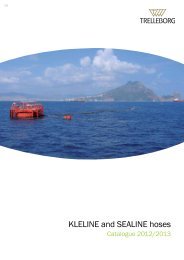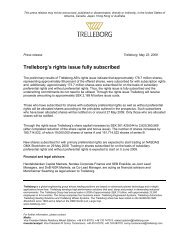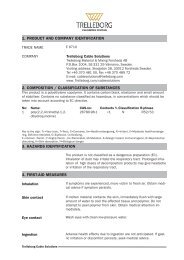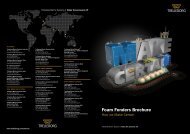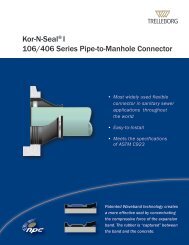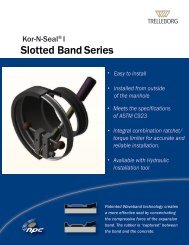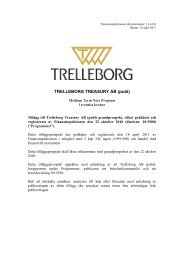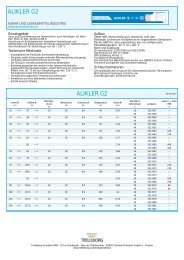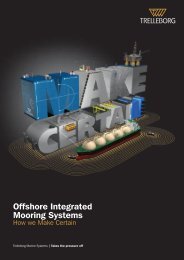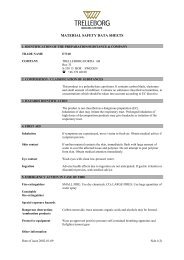Annual report 2011 - Trelleborg
Annual report 2011 - Trelleborg
Annual report 2011 - Trelleborg
You also want an ePaper? Increase the reach of your titles
YUMPU automatically turns print PDFs into web optimized ePapers that Google loves.
Control staff function works in accordance<br />
with an annual plan that is approved<br />
by the Audit Committee. The<br />
plan is based on the risk analysis and<br />
encompasses prioritized companies,<br />
Internal Control at <strong>Trelleborg</strong><br />
<strong>Trelleborg</strong> has defined internal control as a process that is<br />
influenced by the Board of Directors, the Audit Committee,<br />
the President, Group Management and other employees,<br />
and is formulated to provide reasonable assurance that<br />
<strong>Trelleborg</strong>’s goals are achieved in terms of the following:<br />
appropriate and effective business activities<br />
reliable <strong>report</strong>ing<br />
compliance with applicable legislation and regulations.<br />
The Internal Control process is based on a control environment<br />
that creates discipline and provides structure for the<br />
other four components of the process – risk assessment,<br />
control structures, information and communication, and<br />
monitoring. The starting point for the process is the regulatory<br />
framework for internal control issued by the Committee<br />
of Sponsoring Organizations of the Treadway Commission<br />
(CoSo), www.coso.org.<br />
Risk assessment is conducted within the framework of<br />
<strong>Trelleborg</strong>’s Enterprise Risk Management (ERM) process.<br />
This is described in greater detail under Risk and risk<br />
management on pages 28-33.<br />
The control environment includes the values and ethics<br />
upon which the Board, the Audit Committee, the President<br />
and Group Management base their communication and<br />
actions, as well as the Group’s organizational structure,<br />
leadership, decision channels, authorizations, responsibilities<br />
and the expertise of the employees. An overview of the<br />
Group’s organization and governance, including external<br />
and internal steering instruments, which are important<br />
elements of <strong>Trelleborg</strong>’s control environment, is outlined on<br />
pages 42-43. Key internal steering instruments are <strong>Trelleborg</strong>’s<br />
Code of Conduct and <strong>Trelleborg</strong>’s Values. The Code<br />
of Conduct comprises principles for how the business<br />
should be conducted, while Values is a long-term commitment<br />
that is linked to the business concept, objectives and<br />
strategies and guides employees in their day-to-day activities.<br />
<strong>Trelleborg</strong> is characterized by a decentralized organization,<br />
based on management by objectives with clear targets<br />
and performance-based rewards.<br />
GRI: Governance (EC), EN, LA, HR, SO, PR<br />
business areas and processes, as well<br />
as work programs and budgets.<br />
Activities in <strong>2011</strong><br />
In <strong>2011</strong>, the Internal Control Group staff<br />
<strong>Trelleborg</strong>’s goals<br />
Monitoring<br />
function conducted 37 (30) internal audits<br />
in 12 (16) countries, of which nine<br />
(three) were IT security audits. Focus<br />
was on Europe, China, Brazil and the<br />
US. Most of the internal audits were<br />
Risk assessment<br />
CORPORATE GOVERNANCE REPORT<br />
Processes<br />
The control<br />
environment<br />
Information and<br />
communication<br />
Control<br />
structures<br />
Control structures relate to the controls that are chosen to<br />
manage Group risks. Significant controls for <strong>Trelleborg</strong> are<br />
described in more detail on pages 28-33 under Risk and<br />
risk management, and on page 46 with regard to the<br />
significant processes that affect financial <strong>report</strong>ing.<br />
Information and Communication. External information and<br />
communication include, for example, <strong>report</strong>ing to authorities<br />
and external financial <strong>report</strong>ing to owners and other<br />
stakeholders. Internal information and communication refer<br />
to creating awareness among Group employees of external<br />
and internal governance instruments, including authority and<br />
responsibilities. Important tools for this include <strong>Trelleborg</strong>’s<br />
intranet and training programs. A process exists whereby<br />
Group employees affirm in writing that they have knowledge<br />
of Group policies. <strong>Trelleborg</strong>’s whistleblower policy entails<br />
that each employee is entitled, without repercussions, to<br />
<strong>report</strong> suspicions of legal or regulatory violations. Internal<br />
information and communication also pertain to the information<br />
generated by <strong>Trelleborg</strong>’s process for internal<br />
control being fed back to the Board, Audit Committee,<br />
President and Group Management as a basis for making<br />
well-founded decisions.<br />
Monitoring aims to ensure efficiency in the process through<br />
a range of activities, such as the monitoring of operations<br />
in relation to set goals, self-assessments, internal audit<br />
and other monitoring activities.<br />
<strong>Annual</strong> Report <strong>2011</strong> <strong>Trelleborg</strong> AB<br />
45




